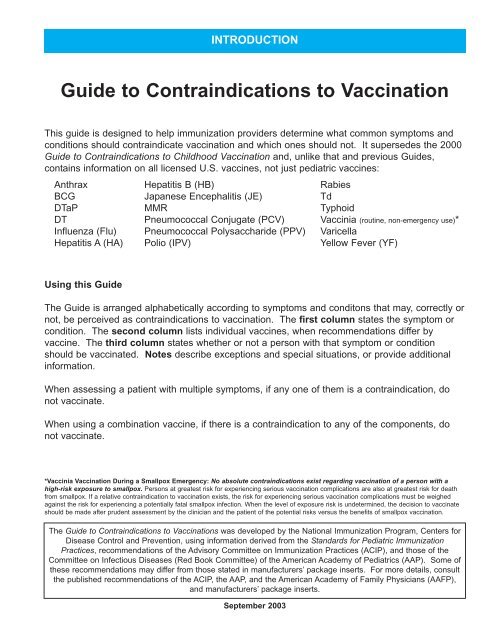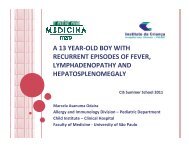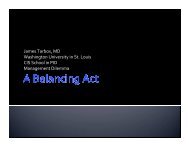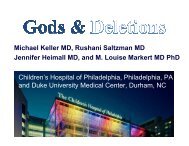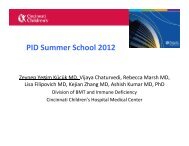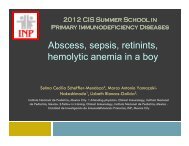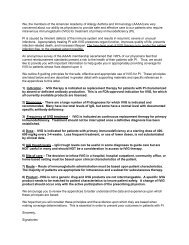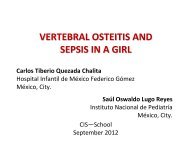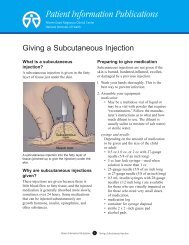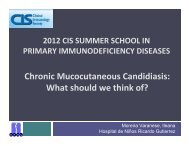Guide to Contraindications to Vaccination - WVSIIS
Guide to Contraindications to Vaccination - WVSIIS
Guide to Contraindications to Vaccination - WVSIIS
Create successful ePaper yourself
Turn your PDF publications into a flip-book with our unique Google optimized e-Paper software.
INTRODUCTION<strong>Guide</strong> <strong>to</strong> <strong>Contraindications</strong> <strong>to</strong> <strong>Vaccination</strong>This guide is designed <strong>to</strong> help immunization providers determine what common symp<strong>to</strong>ms andconditions should contraindicate vaccination and which ones should not. It supersedes the 2000<strong>Guide</strong> <strong>to</strong> <strong>Contraindications</strong> <strong>to</strong> Childhood <strong>Vaccination</strong> and, unlike that and previous <strong>Guide</strong>s,contains information on all licensed U.S. vaccines, not just pediatric vaccines:AnthraxBCGDTaPDTInfluenza (Flu)Hepatitis A (HA)Hepatitis B (HB)Japanese Encephalitis (JE)MMRPneumococcal Conjugate (PCV)Pneumococcal Polysaccharide (PPV)Polio (IPV)RabiesTdTyphoidVaccinia (routine, non-emergency use)*VaricellaYellow Fever (YF)Using this <strong>Guide</strong>The <strong>Guide</strong> is arranged alphabetically according <strong>to</strong> symp<strong>to</strong>ms and condi<strong>to</strong>ns that may, correctly ornot, be perceived as contraindications <strong>to</strong> vaccination. The first column states the symp<strong>to</strong>m orcondition. The second column lists individual vaccines, when recommendations differ byvaccine. The third column states whether or not a person with that symp<strong>to</strong>m or conditionshould be vaccinated. Notes describe exceptions and special situations, or provide additionalinformation.When assessing a patient with multiple symp<strong>to</strong>ms, if any one of them is a contraindication, donot vaccinate.When using a combination vaccine, if there is a contraindication <strong>to</strong> any of the components, donot vaccinate.*Vaccinia <strong>Vaccination</strong> During a Smallpox Emergency: No absolute contraindications exist regarding vaccination of a person with ahigh-risk exposure <strong>to</strong> smallpox. Persons at greatest risk for experiencing serious vaccination complications are also at greatest risk for deathfrom smallpox. If a relative contraindication <strong>to</strong> vaccination exists, the risk for experiencing serious vaccination complications must be weighedagainst the risk for experiencing a potentially fatal smallpox infection. When the level of exposure risk is undetermined, the decision <strong>to</strong> vaccinateshould be made after prudent assessment by the clinician and the patient of the potential risks versus the benefits of smallpox vaccination.The <strong>Guide</strong> <strong>to</strong> <strong>Contraindications</strong> <strong>to</strong> <strong>Vaccination</strong>s was developed by the National Immunization Program, Centers forDisease Control and Prevention, using information derived from the Standards for Pediatric ImmunizationPractices, recommendations of the Advisory Committee on Immunization Practices (ACIP), and those of theCommittee on Infectious Diseases (Red Book Committee) of the American Academy of Pediatrics (AAP). Some ofthese recommendations may differ from those stated in manufacturers’ package inserts. For more details, consultthe published recommendations of the ACIP, the AAP, and the American Academy of Family Physicians (AAFP),and manufacturers’ package inserts.September 2003
CHECK FORAnaphylactic allergiesCHECKLIST (Selected Conditions)REASONContraindicates some vaccinesSEE PAGE(S)1-2Anaphylactic reaction <strong>to</strong> previousdose of any vaccineAnthrax (prior infection)Antimicrobial therapy (current)Eczema or a<strong>to</strong>pic dermatitis inpatient or household contactGuillian-Barré Syndrome, his<strong>to</strong>ry ofHema<strong>to</strong>poietic stem cell transplantHIV (in recipient)Immune globulin (IG)administration, recentIllness (moderate <strong>to</strong> severe acuteillness, fever, otitis, diarrhea,vomiting)Immunodeficiency:-Family his<strong>to</strong>ry-In household contact-In recipientNeurologic disorderPregnancy:-In mother or household contac<strong>to</strong>f recipient-In recipientReaction <strong>to</strong> pevious vaccine doseSkin condition (acute, chronic orexfoliative)Thrombocy<strong>to</strong>penic purpura(his<strong>to</strong>ry)Contraindicates that vaccineContraindicates anthrax vaccinePrecaution for several vaccinesContraindicates vaccinia vaccinePrecaution for DTaP and influenza vaccinesContraindicates varicella vaccine,precaution for several other vaccinesContraindication or precaution for severalvaccinesPrecaution for MMR and varicella vaccinesDeferral of vaccination until recovery maybe prudent-Precaution for varicella vaccine-Contraindicates vaccinia and live flu vaccines-Contraindication or precaution for severalvaccinesPrecaution for DTaP-Contraindicates vaccinia vaccine-Contraindication or precaution for severalvaccinesMay be contraindication or precaution forthat vaccineContraindication for vaccinia vaccinePrecaution for MMR vaccine222344553, 6, 7, 1166677891010
Symp<strong>to</strong>m or Condition Vaccine(s) Vaccinate?Allergies (anaphylactic)<strong>to</strong> any vaccine component (See Appendix A)<strong>to</strong> 2-phenoxyethanol<strong>to</strong> alum<strong>to</strong> baker’s yeast<strong>to</strong> chlortetracycline hydrochloride<strong>to</strong> duck meat or duck feathers<strong>to</strong> eggsAllHA (HAVRIX only)All OthersHAAll OthersHBAll OthersVacciniaAll OthersAllFluYFAll othersNoNoYesNoYesNoYesNoYesYesNo (See Note 1)NoYesNote 1: Pro<strong>to</strong>cols have been published for safely administering influenza vaccine <strong>to</strong> persons with egg allergies.See “Prevention and Control of Influenza,” MMWR 2003;52 (No. RR-8) p. 13.<strong>to</strong> gelatinVaricellaMMRAll OthersSee Note 2See Note 2YesNote 2: If vaccinating persons with a his<strong>to</strong>ry of an anaphylactic reaction <strong>to</strong> gelatin or gelatin-containing productswith MMR or its component vaccines, or with varicella vaccine, extreme caution should be exercised. Beforeadministering these vaccines <strong>to</strong> such persons, skin testing for sensitivity <strong>to</strong> gelatin can be considered. However,no specific pro<strong>to</strong>cols for this purpose have been published.<strong>to</strong> latexAllSee Note 3Note 3: If a person reports a severe (anaphylactic) allergy <strong>to</strong> latex, vaccines supplied in vials or syringes that containnatural rubber should not be administered, unless the benefit of vaccination outweighs the risk of an allergicreaction <strong>to</strong> the vaccine. For latex allergies other than anaphylactic allergies (e.g., a his<strong>to</strong>ry of contact allergy <strong>to</strong>latex gloves), vaccines supplied in vials or syringes that contain dry natural rubber or rubber latex can beadministered.<strong>to</strong> neomycinMMRIPVVacciniaVaricellaAll OthersNoNoNoNoYes<strong>to</strong> penicillinAllYes1
Symp<strong>to</strong>m or Condition Vaccine(s) Vaccinate?Allergies, continued<strong>to</strong> polymyxin B<strong>to</strong> proteins of rodent or neural origin<strong>to</strong> strep<strong>to</strong>mycinnonspecific or nonanaphylacticin relatives<strong>to</strong> thimerosalAnaphylactic (life-threatening) reaction <strong>to</strong>previous dose of vaccineIPVVacciniaAll OthersJEAll OthersIPVVacciniaAll OthersAllAllJEAll OthersAllNoNoYesNoYesNoNoYesYesYesNoYesNo (See Note 4)Note 4: Contraindicates vaccination only with vaccine <strong>to</strong> which reaction occurred. (Also, see “Allergies,” pp 1 - 2).Anthrax, prior infectionAnthraxAll OthersNoYesAntimicrobial therapy (current)Flu (LAIV only)VaricellaTyphoidAll OthersYes (See Note 5)Yes (See Note 6)Yes (See Note 7)YesNote 5: It is not known whether administering influenza antiviral medications affects the safety or efficacy of live,attenuated influenza vaccine (LAIV); LAIV should not be administered until 48 hours following cessation ofinfluenza antiviral therapy, and influenza antiviral medications should not be administered for two weeks followingreceipt of LAIV.Note 6: Antiviral drugs active against herpesviruses (e.g., acyclovir or valacyclovir) might reduce the efficacy of liveattenuated varicella vaccine. These drugs should be discontinued >24 hours before the administration of varicellavaccine, if possible.Note 7: The vaccine manufacturer advises that Ty21a should not be administered <strong>to</strong> persons receiving sulfonamidesor other antimicrobial agents. Ty21a should be administered >24 hours after an antimicrobial dose.Mefloquine can inhibit the growth of the live Ty21a strain in vitro; if this antimalarial is administered, vaccinationwith Ty21a should be delayed for 24 hours.Aspirin or salicylate therapy (children oradolescents)2Flu (LAIV only)All OthersNoYes
Symp<strong>to</strong>m or Condition Vaccine(s) Vaccinate?Blood Disorders(Also see Thrombocy<strong>to</strong>penia, p. 10)Note 8: Persons with hemoglobinopathies should not get LAIV.Flu (LAIV only)All OthersSee Note 8Yes (See Note 9)Note 9: When [any] intramuscular vaccine is indicated for a patient with a bleeding disorder or a person receivinganticoagulant therapy, the vaccine should be administered intramuscularly if, in the opinion of a physician familiarwith the patient's bleeding risk, the vaccine can be administered with reasonable safety by this route. If the patientreceives antihemophilia or similar therapy, intramuscular vaccinations can be scheduled shortly after such therapyis administered. A fine needle (2 minutes. The patient or family should be instructed concerning the risk for hema<strong>to</strong>mafrom the injection.Breastfeeding (vaccinate nursing infant)Breastfeeding (vaccinate lactating mother)Convalescing from illnessConvulsions (fits, seizures), family his<strong>to</strong>ry(including epilepsy)AllVacciniaAll OthersAllAllYesNoYesYesYes (See Note 10)Note 10: Consider giving acetaminophen before DTaP and every 4 hours thereafter for 24 hours <strong>to</strong> children whohave a personal or a family his<strong>to</strong>ry of convulsions. (If an underlying neurologic disorder is involved, also see page7.)Convulsions (fits, seizures) within 3 days ofprevious dose of DTaPDTaPAll OthersSee Note 11YesNote 11: Not a contraindication, but a precaution. Consider carefully the benefits and risks of this vaccine in thesecircumstances. If the risks are believed <strong>to</strong> outweigh the benefits, withhold the vaccination; if the benefits arebelieved <strong>to</strong> outweigh the risks (for example, during an outbreak or foreign travel), give the vaccine. (If convulsionsare accompanied by encephalopathy, also see page 8. If an underlying neurologic disorder is involved, also seepage 7.)DiarrheaMild (with or without low-grade fever)Moderate <strong>to</strong> severe (with or without fever)AllAllYesSee Note 12Note 12: Persons with moderate or severe illnesses, with or without fever, can be vaccinated as soon as they arerecovering and no longer acutely ill.Eczema or A<strong>to</strong>pic Dermatitis (presence or his<strong>to</strong>ryof, or household contact with his<strong>to</strong>ry of)Encephalopathy (See “Reaction after a previousdose of DTaP,” p. 9)VacciniaAll OthersNoYes3
Symp<strong>to</strong>m or Condition Vaccine(s) Vaccinate?Exposure (recent) <strong>to</strong> infectious diseaseFeverLow-grade fever with or without mild illnessFever with moderate <strong>to</strong> severe illnessAllAllAllYesYesSee Note 12 (above)Guillain Barré Syndrome (GBS), his<strong>to</strong>ry ofFlu (LAIV)Flu (Inactivated)DTaPAll OthersNoSee Note 13See Note 14YesNote 13: Whether influenza vaccination specifically might increase the risk for recurrence of GBS is not known;therefore, avoiding vaccinating persons who are not at high risk for severe influenza complications and who areknown <strong>to</strong> have developed GBS within 6 weeks after a previous influenza vaccination is prudent. Although data arelimited, for the majority of persons who have a his<strong>to</strong>ry of GBS and who are at high risk for severe complicationsfrom influenza, the established benefits of influenza vaccination justify yearly vaccination.Note 14: The decision <strong>to</strong> give additional doses of DTaP <strong>to</strong> children who developed GBS within 6 weeks of a priordose should be based on consideration of the benefits of further vaccination vs. the risk of recurrence of GBS. Forexample, completion of the primary series in children is justified.Heart ConditionsVacciniaFlu (LAIV only)All OthersNo (See Note 15)(See Note 16)YesNote 15: As a precaution, a patient who has been diagnosed by a doc<strong>to</strong>r as having a heart condition with or withoutsymp<strong>to</strong>ms should not get the smallpox vaccine at this time while experts continue their investigations. Theseconditions include: known coronary disease including previous myocardial infarction or angina, congestive heartfailure, cardiomyopathy, stroke or transient ischemic attack, chest pain or shortness of breath with activity, or otherheart conditions under the care of a doc<strong>to</strong>r.In addition, a patient should not get smallpox vaccine who has 3 or more of the following fac<strong>to</strong>rs:- has been diagnosed with high blood pressure- has been diagnosed with high blood cholesterol- has been diagnosed with diabetes or high blood sugar- has a first degree relative who had a heart condition before the age of 50- smokes cigarettesNote 16: Persons with chronic disorders of the cardiovascular system should not get live, attenuated influenzavaccine.Hema<strong>to</strong>poietic Stem Cell Transplant (HSCT)VaricellaAll OthersNoSee Note 17Note 17: Other vaccines are recommended, or may be given, at varying times after transplant and under certaincircumstances. For some vaccines, no data exist. Use of live vaccines is indicated only among immunocompetentpesons and is contraindicated for recipients after HSCT who are not presumed immunocompetent.HSCT recipients are presumed immunocompetent at >24 months after HSCT if they are not on immunosuppressivetherapy and do not have graft-versus-host disease. For more information, see “<strong>Guide</strong>lines forPreventing Opportunistic Infections Among Hema<strong>to</strong>poietic Stem Cell Transplant Recipients” (MMWR Vol 49 NoRR-10, Oc<strong>to</strong>ber 20, 2000), especially Tables 4 and 6.4
Symp<strong>to</strong>m or Condition Vaccine(s) Vaccinate?HIV infectionin recipient (asymp<strong>to</strong>matic)in recipient (symp<strong>to</strong>matic)in household contactFlu (LAIV only)Typhoid (Ty21a only)VacciniaVaricellaMMRBCGYFAll OthersFlu (LAIV only)Typhoid (Ty21a only)VacciniaVaricellaMMRBCGYFAll OthersFlu (LAIV only)VacciniaAll OthersNoNoNoSee Note 18See Note 19NoNoYesNoNoNoSee Note 18See Note 20NoNoYesNoNoYesNote 18: Varicella vaccination should be considered for asymp<strong>to</strong>matic or mildly symp<strong>to</strong>matic HIV-infected children,specifically children in CDC class N1 or A1*, with age-specific T-cell percentages of 25% or higher.Note 19: MMR vaccination is recommended for all asymp<strong>to</strong>matic HIV-infected persons who do not have evidenceof severe immunosuppression** for whom measles vaccination would otherwise be indicated.Note 20: MMR vaccination should be considered for all symp<strong>to</strong>matic HIV-infected persons who do not haveevidence of severe immunosuppression** or of measles immunity.*See “Prevention of Varicella” (MMWR Vol 8 No RR-6, May 28, 1999) p. 3 footnote.**For definition of severe immunosuppression, see 2003 AAP Red Book, Table 3.25, p. 364.IG administration, recent or simultaneous(intramuscular or intravenous)MMRVaricellaAll OthersSee Note 21See Note 22YesNote 21: Do not give immune globulin products and MMR simultaneously. If unavoidable, give at different sitesand revaccinate or test for seroconversion in 3 months. If MMR is given first, do not give IG for 2 weeks. If IG isgiven first, the interval between IG and measles vaccination depends on the product, the dose, and the indication.(See Appendix B.)Because of the importance of rubella immunity among childbearing-age women, the postpartum vaccination ofrubella-susceptible women with rubella or MMR vaccine should not be delayed because of receipt of anti-Rho(D)globulin or any other blood product during the last trimester of pregnancy or at delivery. These women should bevaccinated immediately after delivery and, if possible, tested >3 months later <strong>to</strong> ensure immunity <strong>to</strong> rubella and, ifnecessary, <strong>to</strong> measles.5
Symp<strong>to</strong>m or Condition Vaccine(s) Vaccinate?Note 22: Do not give varicella vaccine for at least 5 months after administration of blood (except washed redblood cells) or after plasma tranfusions, IG, or VZIG. Do not give IG or VZIG for 3 weeks after vaccination unlessthe benefits exceed those of the vaccination. In such instances, either revaccinate 5 months later or test for immunity6 months later and revaccinate if seronegative.Illnessmild acute (with or without low-grade fever)moderate or severe acute (with or withoutfever)chronicAllAllFlu (LAIV only)All OthersYesSee Note 23See Note 24See Note 25Note 23: Persons with moderate or severe illnesses, with or without fever, can be vaccinated as soon as they arerecovering and no longer acutely ill.Note 24: Persons with asthma, reactive airways disease or other chronic disorders of the pulmonary or cardiovascularsystems; persons with other underlying medical conditions, including metabolic diseases such as diabetes,renal dysfunction, and hemoglobinopathies should not receive LAIV.Note 25: The great majority of persons with chronic illnesses should be appropriately vaccinated. The decisionwhether or not <strong>to</strong> vaccinate these persons, and what vaccines <strong>to</strong> give, should be made on an individual basis.ImmunodeficiencySee also “HIV Infection” (page 5); recommendations differslightlyfamily his<strong>to</strong>ryVaricellaAll OthersSee Note 26Yesin household contactFlu (LAIV only)VacciniaAll OthersNo (See Note 27)NoYes.in recipient(hema<strong>to</strong>logic and solid tumors, congenital immunodeficiency,long-term immunosuppressive therapy,including steroids)Flu (LAIV only)MMRPPVRabiesTyphoid (Ty21a only)VacciniaVaricellaBCGYFAll OthersNoNoSee Note 28See Note 29NoNoSee Note 30NoNoYes6
Symp<strong>to</strong>m or Condition Vaccine(s) Vaccinate?Note 26: Varicella vaccine should not be administered <strong>to</strong> a person with a family his<strong>to</strong>ry of congenital or hereditaryimmunodeficiency in parents or siblings unless that person’s immune competence has been clinically substantiatedor verified by a labora<strong>to</strong>ry.Note 27: There are no data assessing the risk of transmission of LAIV from vaccine recipients <strong>to</strong> immunosuppressedcontacts. In the absence of such data, use of inactivated flu vaccine is preferred for vaccinatinghousehold members, healthcare workers, and others who have close contact with immunosuppressed individuals.Note 28: When cancer chemotherapy or other immunosuppressive therapy is being considered (e.g., for patientswith Hodgkins disease or those who undergo organ or bone marrow transplantation), the interval betweenvaccination and initiation of immunosuppressive therapy should be at least 2 weeks. <strong>Vaccination</strong> duringchemotherapy or radiation therapy should be avoided.Note 29: Preexposure: Patients who are immunosuppressed by disease or medications should postpone preexposurevaccinations and consider avoiding activities for which rabies preexposure prophylaxis is indicated.When this course is not possible, immunosuppressed persons who are at risk for rabies should be vaccinated bythe IM route and their antibody titers checked. Failure <strong>to</strong> seroconvert after the third dose should be managed inconsultation with appropriate public health officials. Postexposure: Immunosuppressive agents should not beadministered during postexposure therapy unless essential for treatment of other conditions. When postexposureprophylaxis is administered <strong>to</strong> an immunosuppressed person, it is especially important that a serum sample betested for rabies antibody <strong>to</strong> ensure that an acceptable antibody response has developed.Note 30: Varicella vaccine should not be administered <strong>to</strong> persons who have cellular immunodeficiencies, butpersons with impaired humoral immunity may be vaccinated. A pro<strong>to</strong>col exists for use of varicella vaccine inpatients with acute lymphoblastic leukemia (ALL). See “Prevention of Varicella: Recommendations of theAdvisory Committee on Immunization Practices” MMWR 1996;45 (No. RR-11).Neurologic disorders, underlying (includingseizure disorders, cerebral palsy, anddevelopmental delay)DTaPAll OthersSee Note 31YesNote 31: Whether and when <strong>to</strong> administer DTaP <strong>to</strong> children with proven or suspected underlying neurologicdisorders should be decided individually. Generally, infants and children with stable neurologic conditions,including well-controlled seizures, may be vaccinated.Otitis mediamild (with or without low-grade fever)moderate or severe (with or without fever)resolvingAllAllAllYesSee Note 32YesNote 32: Children with moderate or severe illnesses, with or without fever, can be vaccinated as soon as they arerecovering and no longer acutely ill.Pregnancyin mother or household contact of recipientVacciniaAll OthersNoYesContinued7
Symp<strong>to</strong>m or Condition Vaccine(s) Vaccinate?Pregnancy (continued)in recipientMMRVaricellaFlu (LAIV only)BCGVacciniaIPVHAJEYFPPVTyphoidAll OthersNo (See Note 33)No (See Note 33)NoNoNoSee Note 34See Note 35See Note 36See Note 37See Note 38See Note 38YesNote 33: Women should avoid becoming pregnant for 4 weeks following vaccination.Note 34: If a pregnant woman is at increased risk for infection and requires immediate protection against polio, IPVcan be administered in accordance with the recommended schedules for adults.Note 35: The theoretical risk <strong>to</strong> the developing fetus is expected <strong>to</strong> be low. The risk associated with vaccinationshould be weighed against the risk for hepatitis A in women who may be at high risk for exposure <strong>to</strong> hepatitis Avirus.Note 36: Pregnant women who must travel <strong>to</strong> an area where risk of JE is high should be vaccinated when the theoreticalrisks of immunization are outweighed by the risk of infection <strong>to</strong> the mother and developing fetus.Note 37: Pregnant women should not be routinely vaccinated on theoretical grounds, and travel <strong>to</strong> areas whereyellow fever is present should be postponed until after delivery. If international travel requirements constitute theonly reason <strong>to</strong> vaccinate a pregnant woman, rather than an increased risk of infection, efforts should be made <strong>to</strong>obtain a waiver letter from the traveler’s physician. Pregnant women who must travel <strong>to</strong> areas where the risk ofyellow fever is high should be vaccinated.Note 38: Vaccine is not contraindicated, but no data exist on its use among pregnant women.PrematurityHBAll OthersYes (See Note 39)Yes (See Note 40)Note 39: If an infant weighs less than 2 kg at birth, and the mother is antigen-negative, this infant can receive thefirst dose of hepatitis B vaccine at chronological age 1 month. Premature infants discharged from the hospitalbefore chronological age 1 month can also be administered hepatitis B vaccine at discharge, if they are medicallystable and have gained weight consistently. If the mother is antigen-positive or if her antigen status is not known,use the vaccine schedule in which the first dose, plus HBIG, is given within 12 hours of birth, regardless of theinfant’s birth weight. If these infants weigh less than 2 kg at birth, this initial dose should not be counted <strong>to</strong>wardcompletion of the hepatitis B vaccine series, and three additional doses should be administered beginning whenthe infant is 1 month of age.Note 40: The appropriate age for initiating vaccinations in the prematurely born infant is the usual chronologicalage (same dosage and indications as for normal, full-term infants).8
Symp<strong>to</strong>m or Condition Vaccine(s) Vaccinate?Reaction <strong>to</strong> a previous dose of any vaccineanaphylactic (life-threatening)local (mild-<strong>to</strong>-moderate soreness, redness,swelling)AllAllNo (See Note 41)YesNote 41: Contraindicates vaccination only with vaccine <strong>to</strong> which reaction occurred. If tetanus <strong>to</strong>xoid is contraindicatedfor someone who has not completed a primary tetanus series and that person has a wound that is neitherclean nor minor, give only passive vaccination, using tetanus immune globulin (TIG).Reaction after a previous dose of DTaPcollapse or shock-like state within 48 hours ofdosepersistent, inconsolable crying lasting for 3 ormore hours, occurring within 48 hours of doseencephalopathy within 7 days after dosefamily his<strong>to</strong>ry of any adverse event after adosefever of 40.5 O C (105 O F) within 48 hoursafter a doseGuillain-Barré syndrome (GBS) within 6 weeksafter a doseseizures within 3 days after a doseDTaPDTaPDTaPDTaPDTaPDTaPDTaPDTaPSee Note 42See Note 42NoYes (See Note 43)Yes (See Note 43)See Notes 42 & 43See Note 44See Notes 42 & 43Note 42: Not a contraindication, but consider carefully the benefits and risks of this vaccine under these circumstances.If the risks are believed <strong>to</strong> outweigh the benefits, withhold the vaccination; if the benefits are believed <strong>to</strong>outweigh the risks (for example, during an outbreak or foreign travel), give the vaccine.Note 43: Consider giving acetaminophen before DTaP and every 4 hours thereafter for 24 hours.Note 44: The decision <strong>to</strong> give additional doses of DTaP should be based on consideration of the benefits of furthervaccination vs. the risk of recurrence of GBS. For example, completion of the primary series in children is justified.9
Symp<strong>to</strong>m or Condition Vaccine(s) Vaccinate?Simultaneous administration of vaccinesAllYes (See Note 45)Note 45: There is a theoretical risk that the administration of multiple live virus vaccines within 4 weeks of oneanother, if not given on the same day, will result in a suboptimal immune response. Parenterally administered livevaccines, and live attenuated influenza vaccine, when not administered on the same day should be administered>4 weeks apart whenever possible. If these live vaccines are separated by 4 weeks after the last, invalid, dose.Skin condition (acute, chronic or exfoliative) inrecipient or household contactVacciniaAll OthersNo (See Note 46)YesNote 46: <strong>Vaccination</strong> may be administered after condition resolves. (Recommendations differ for Eczema andA<strong>to</strong>pic Dermatitis. See p. 9)Sudden infant death syndrome (SIDS), familyhis<strong>to</strong>rySteroids (See “Immunodeficiency,” p. 6)Steroid Eye DropsThrombocy<strong>to</strong>penia, or his<strong>to</strong>ry ofthrombocy<strong>to</strong>penic purpuraAllVacciniaAll OthersMMRAll OthersYesNoYesSee Note 47YesNote 47: Consider the benefits of immunity <strong>to</strong> measles, mumps, and rubella vs. the risk of recurrence or exacerbationof thrombocy<strong>to</strong>penia after vaccination, or risk from natural infections of measles or rubella. In most instances,the benefits of vaccination will be much greater than the potential risks and will justify giving MMR, particularly inview of the even greater risk of thrombocy<strong>to</strong>penia following measles or rubella disease. However, if a priorepisode of thrombocy<strong>to</strong>penia occurred near the time of vaccination, it might be prudent <strong>to</strong> avoid a subsequentdose.Tuberculin skin testing, performedsimultaneously with vaccinationMMRVaricellaVacciniaYFAll OthersYes (See Note 48)Yes (See Note 49)Yes (See Note 49)Yes (See Note 49)YesNote 48: Measles vaccination may temporarily suppress tuberculin reactivity. MMR vaccine may be given after, oron the same day as, TB testing. If MMR has been given recently, postpone the TB test until 4-6 weeks afteradministration of MMR. If giving MMR simultaneously with tuberculin skin test, use the Man<strong>to</strong>ux test, not multiplepuncture tests, because the latter, if results are positive, require confirmation (and confirmation would then have <strong>to</strong>be postponed 4-6 weeks).Note 49: No data exist for the potential degree of PPD suppression that might be associated with other parenterallive attenuated virus vaccines. Nevertheless, in the absence of data, following guidelines for measles-containingvaccine when scheduling PPD screening and administering other parenteral live attenuated virus vaccines isprudent.10
Symp<strong>to</strong>m or Condition Vaccine(s) Vaccinate?Tuberculosis (TB) or positive PPDMMRVaricellaAll OthersSee Note 50See Note 51YesNote 50: A theoretical basis exists for concern that measles vaccine might exacerbate tuberculosis. Consequently,before administering MMR <strong>to</strong> persons with untreated active tuberculosis, initiating antituberculosis therapy isadvisable.Note 51: Although no data exist regarding whether either varicella or live varicella virus vaccine exacerbates tuberculosis,vaccination is not recommended for persons who have untreated, active tuberculosis.Unvaccinated household contactVomitingmild (with or without low-grade fever)moderate or severe (with or without fever)AllAllAllYesYesSee Note 52Note 52: Persons with moderate or severe illnesses, with or without fever, can be vaccinated as soon as they arerecovering and no longer acutely ill.11
Appendix A: Vaccine ContentsAppendix ASummary of Contents ofVaccines Licensed in the U.S.In addition <strong>to</strong> identifying specific substances that contraindicate certain vaccines (shown underthe category “Allergies” on pages 1 and 2 of this <strong>Guide</strong>), the ACIP also makes the more generalstatement that a “serious allergic reaction [e.g., anaphylaxis] <strong>to</strong> a vaccine component” is a contraindication.The following table summarizes excipients (i.e., inert substances added as a vehicle) containedin vaccines licensed in the United States While these substances, except as noted above, arenot specified by the ACIP as contraindications <strong>to</strong> vaccination, providers should be aware of substancescontained in vaccines should they encounter a patient with a known anaphylactic allergy.VaccineAnthrax (BioThrax)BCG (Tice)DTaP (Daptacel)DTaP (Infanrix)DTaP (Tripedia)DTaP (Mostbrands)DTaP/Hib (TriHIBit)ContainsAluminum hydroxide, Benzethonium chloride, Formaldehyde or formalin,Sodium chlorideLac<strong>to</strong>se, Sodium chlorideAluminum phosphate, Formaldehyde or formalin, Sodium chloride,2-phenoxyethanolFormaldehyde or formalin, 2-phenoxyethanol, Phosphate buffers (e.g.,disodium, monosodium, potassium, sodium dihydrogen phosphate),Polysorbate 80, Sodium chlorideAluminum potassium sulfate, Formaldehyde or formalin, Gelatin,Phosphate buffers (e.g., disodium, monosodium, potassium, sodium dihydrogenphosphate), Polysorbate 80, Sodium chloride, Thimerosal*Hydrochloric acidAluminum potassium sulfate, Formaldehyde or formalin, Gelatin,Phosphate buffers (e.g., disodium, monosodium, potassium, sodium dihydrogenphosphate), Polysorbate 80, Sodium chloride, Thimerosal*,Ammonium sulfate, SucroseA-1
Appendix A: Vaccine ContentsVaccineDTaP/HepB/IPV(Pediarix)DT (Aventis)DT(Massachusetts)DT (Some brands)Hib (ACTHib)Hib (PedvaxHib)Hib (HibTITER)Hib (Some packages)Hib/HepB(Comvax)Hep A (Havrix)Hep A (Vaqta)Hep B (Engerix-B)Hep B(Recombivax)Contains2-phenoxyethanol, Sodium chloride, Aluminum, Formaldehyde,Polysorbate 80, Thimerosal*, Neomycin, Polymyxin B, Yeast proteinAluminum potassium sulfate, Formaldehyde or formalin, Sodium chloride,ThimerosalAluminum hydroxide, Formaldehyde or formalin, Sodiumchloride, ThimerosalGlycine, Hydrochloric acid, Phosphate buffers (e.g., disodium, monosodium,potassium, sodium dihydrogen phosphate), Sodium acetate, SodiumhydroxideAmmonium sulfate, Formaldehyde or formalin, Phosphate buffers (e.g.,disodium, monosodium, potassium, sodium dihydrogen phosphate),Sodium chloride, SucroseAluminum hydroxide, Sodium chlorideYeast protein, Thimerosal (multi-dose)Lac<strong>to</strong>seAluminum hydroxide, Sodium borate, Sodium chloride, Yeast proteinAluminum hydroxide, Amino acids, Bovine albumin or serum,Formaldehyde or formalin, MRC-5 cellular protein, 2-phenoxyethanol,Phosphate buffers (e.g., disodium, monosodium, potassium, sodium dihydrogenphosphate), Polysorbate 20, Sodium chlorideAluminum hydroxide, Bovine albumin or serum, DNA, Formaldehyde orformalin, MRC-5 cellular protein, Sodium borate, Sodium chlorideAluminum hydroxide, Phosphate buffers (e.g., disodium, monosodium,potassium, sodium dihydrogen phosphate) , Sodium chloride, Yeast protein,Thimerosal*Aluminum hydroxide, Sodium chloride, Yeast proteinA-2
Appendix A: Vaccine ContentsVaccineHepA/HepB(Twinrix)Influenza (Fluvirin)Influenza (Fluzone)Influenza (FluMist)Influenza (varies)IPV (Ipol)JapaneseEncephalitis(JE-Vax)Measles(Attenuvax)Meningococcal(Menomune)Mumps(Mumpsvax)MMR (MMR-II)Pneumococcal(Pneumovax)Pneumococcal(Prevnar)Rabies (BioRab)ContainsPhosphate-buffer sodium chloride, Alunimum phosphate, Aluminumhydroxide, 2-phenoxyethanol, Amino acids, Polysorbate 20, Formalin,Thimerosal*, Yeast protein, Neomycin sulfateBeta-propiolac<strong>to</strong>ne, Egg protein, Neomycin, Polymyxin B,Polyoxyethylene 9-10 nonyl phenol (Tri<strong>to</strong>n N-101, oc<strong>to</strong>xynol 9), Sodiumchloride, ThimerosalEgg protein, Formaldehyde or formalin, Gelatin, Polyethylene glycolp-isooctylphenyl ether (Tri<strong>to</strong>n X-100), Sodium chloride, ThimerosalEgg protein, Gentamicin, Monosodium glutamate, Sucrose, PotassiumphosphateBac<strong>to</strong>pep<strong>to</strong>neFormaldehyde or formalin, Neomycin, 2-phenoxyethanol, Phosphatebuffers (e.g., disodium, monosodium, potassium, sodium dihydrogenphosphate) , Polymyxin B, Sodium chloride, Strep<strong>to</strong>mycinFormaldehyde or formalin, Gelatin, Mouse serum proteinGelatin, Neomycin, Sorbi<strong>to</strong>lLac<strong>to</strong>se, Thimerosal*Gelatin, Neomycin, Sorbi<strong>to</strong>lGelatin, Neomycin, Sorbi<strong>to</strong>lPhenol, Sodium chlorideAluminum phosphate, Sodium chlorideAluminum phosphate, Phosphate buffers (e.g., disodium, monosodium,potassium, sodium dihydrogen phosphate), ThimerosalA-3
Appendix A: Vaccine ContentsVaccineAppendix A: Vaccine ContentsContainsRabies (Imovax)Rabies (RabAvert)Rubella(Meruvax II)Td (Aventis)Td (Massachusetts)Typhoid (inactivated- Typhim Vi)Typhoid(oral - TY21a)Vaccinia (DryVax)Varicella (Varivax)Yellow Fever(YF-Vax)Beta-propiolac<strong>to</strong>ne, Bovine albumin or serum, Human serum albumin,MRC-5 cellular protein, Neomycin, Phenol red (phenolsulfonphthalein),Sodium chloride, Vitamins (unspecified)Amphotericin B, Beta-propiolac<strong>to</strong>ne, Bovine albumin or serum,Chlortetracycline, Ethylenediamine-tetraacetic acid sodium (EDTA),Gelatin, MRC-5 cellular protein, Neomycin, Ovalbumin, Potassium glutamate,Sodium chlorideGelatin, Neomycin, Sorbi<strong>to</strong>lAluminum potassium sulfate, Formaldehyde or formalin, Sodium chloride,Thimerosal, (may contain Glycine, Sodium acetate, Sodium hydroxide)Aluminum hydroxide, Aluminum Phosphate, Formaldehyde or formalin,Sodium chloride, Thimerosal, (may contain Glycine, Sodium acetate,Sodium hydroxide)Phenol, Phosphate buffers (e.g., disodium, monosodium, potassium,sodium dihydrogen phosphate), Polydimethylsilozone, Sodium chlorideAmino acids, Ascorbic acid, Gelatin, Lac<strong>to</strong>se, Magnesium stearate,SucroseBovine albumin or serum, Brilliant green, Chlortetracycline, Glycerin,Neomycin, Phenol, Polymyxin B, Strep<strong>to</strong>mycinBovine albumin or serum, Ethylenediamine-tetraacetic acid sodium(EDTA), Gelatin, Monosodium glutamate, MRC-5 cellular protein,Neomycin, Phosphate buffers (e.g., disodium, monosodium, potassium,sodium dihydrogen phosphate), Sodium chloride, SucroseEgg protein, Gelatin, Sodium chloride, Sorbi<strong>to</strong>l*Whenever “thimerosal” is marked with an asterisk (*) it indicates that the product should be considered equivalent<strong>to</strong> thimerosal-free products. This vaccine may contain trace amounts (
Appendix B: IG-Live Vaccine IntervalsAppendix BSuggested Intervals Between Administration ofAntibody-Containing Products for Different Indications andMeasles-Containing Vaccine and Varicella Vaccine*Product/IndicationDose (Including mg immunoglobulin G(IgG)/kg body weight*Suggested Intervalbefore Measles orVaricella <strong>Vaccination</strong>Respira<strong>to</strong>ry syncytial virus immuneglobulin (IG) monoclonal antibody(Synagis TM )**Tetanus IGHepatitis A IGContact prophylaxisInternational travelHepatitis B IGRabies IGVaricella IGMeasles prophylaxis IGStandard (i.e., nonimmunocompromised)contactImmunocompromised contactBlood transfusionRed blood cells (RBCs), washedRBCs, adenine-saline addedPacked RBCs (Hct 65%)***Whole blood (Hct 35-50%)***Plasma/platelet productsCy<strong>to</strong>megalovirus (IGIV)RSV prophylaxis (IGIV)IGIVReplacement therapy for immunedeficiencies****Immune thrombocy<strong>to</strong>penic purpuraImmune thrombocy<strong>to</strong>penic purpuraKawasaki disease15 mg/kg intramuscularly (IM)250 units (10 mg IgG/kg) IM0.02 mL/kg (3.3 mg IgG/kg) IM0.06 mL/kg (10 mg IgG/kg) IM0.06 mL/kg (10 mg IgG/kg) IM20 IU/kg (22 mg IgG/kg) IM125 units/10kg (20-40 mg IgG/kg) IM(maximum 625 units)0.25 mL/kg (40 mg IgG/kg) IM0.50 mL/kg (80 mg IgG/kg) IM10 mL/kg negligible IgG/kg intravenously (IV)10 mL/kg (10 mg IgG/kg) IV10 mL/kg (60 mg IgG/kg) IV10 mL/kg (80-100 mg IgG/kg) IV10 mL/kg (160 mg IgG/kg) IV150 mg/kg maximum750 mg/kg300-400 mg/kg IV****400 mg/kg IV1000 mg/kg IV2 grams/kg IVNone3 months3 months3 months3 months4 months5 months5 months6 monthsNone3 months6 months6 months7 months6 months9 months8 months8 months10 months11 months*This table is not intended for determining the correct indications and dosage for using antibody-containing products.Unvaccinated persons might not be fully protected against measles during the entire recommended interval, and additionaldoses of immune globulin or measles vaccine might be indicated after measles exposure. Concentrations of measles antibodyin an immune globulin preparation can vary by manufacturer’s lot. Rates of antibody clearance after receipt of an immune globulinpreparation might vary also. Recommended intervals are extrapolated from an estimated half-life of 30 days for passivelyacquired antibody and an observed interference with the immune response <strong>to</strong> measles vaccine for 5 months after a dose of 80mg IgG/kg. (Source: Mason W, Takahashi M, Schneider T. Persisting passively acquired measles antibody following gammaglobulin therapy for Kawasaki disease and response <strong>to</strong> live virus vaccination [Abstract 311]. Presented at the 32nd meeting ofthe Interscience Conference on Antimicrobial Agents and Chemotherapy, Los Angeles, California, Oc<strong>to</strong>ber, 1992.)**Contains antibody only <strong>to</strong> respira<strong>to</strong>ry syncytial virus (RSV)***Assumes a serum IgG concentration of 16 mg/mL****Measles and varicella vaccination is recommended for children with asymp<strong>to</strong>matic or mildly symp<strong>to</strong>matic human immunodeficiencyvirus (HIV) infection but is contraindicated for persons with severe immunosuppression from HIV or any other immunosuppressivedisorder.Adapted from ACIP “General Recommendations on Immunization” February 8, 2002B-1
Help us Improve the <strong>Guide</strong> <strong>to</strong> <strong>Contraindications</strong>Send us your feedback and tell us how we can make the <strong>Guide</strong> <strong>to</strong><strong>Contraindications</strong> <strong>to</strong> <strong>Vaccination</strong>s more useful.Are there other conditions you would like <strong>to</strong> see included? Did youprefer the smaller format of previous editions? Are there changesthat would make it easier <strong>to</strong> use? Are there sections that are notclear?Send your comments <strong>to</strong> crw4@cdc.gov. We cannot guarantee thatall suggestions will be incorporated, but they will all be read andgiven serious consideration.


